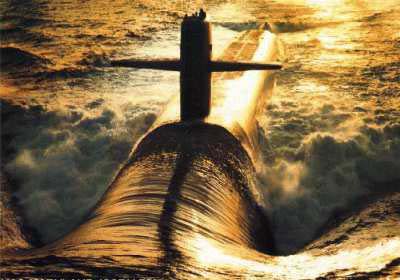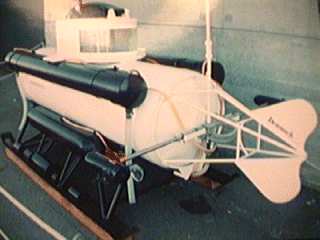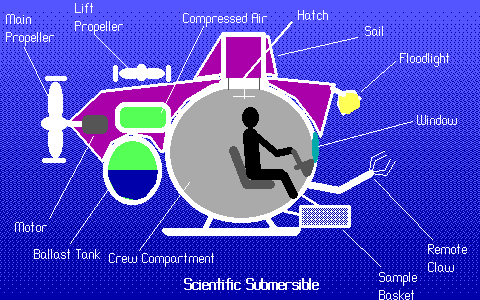pop up description layer
HOME
Cryptozoology UFO Mysteries Aviation Space & Time Dinosaurs Geology Archaeology Exploration 7 Wonders Surprising Science Troubled History Library Laboratory Attic Theater Store Index/Site Map Cyclorama
Search the Site: |
|
Submarines x
Man has long sought a way to explore the world beneath the water. One of his solutions is the submarine. A submarine is a vessel capable of operating completely underwater. Deep water submarines fall into two categories: military and scientific. Military submarines are designed to be used as weapons during time of war. They are capable of traveling great distances, while remaining out of port. Usually they have crews of from 50 to 100 sailors. These subs carry torpedoes and missiles, both armed with explosive warheads that can be launched against enemy surface ships, other submarines, or even land targets, to destroy them. Scientific submarines are smaller, with a crew of two or three, and operate in a small specific area. Always a surface support ship is nearby to assist the sub and provide a home for the crew when the boat is not being used. A typical mission for a scientific submarine would be examining sea life on the bottom or looking for a sunken ship. These type of submarines often have mechanical claws mounted on the hull allowing the crew to grab something they see and put it in a mesh basket attached to the sub so it can be brought to the surface. The first known submarine was the Drebbel built for James I of England in 1620. It operated in the Thames river and moved by use of oars that extended through sealed oarlocks. David Bushnell's Turtle was the first combat submarine. The turtle looked like an oversized barrel and used a mine to make it's attack. On September 6, 1776, the Turtle approached the British ship Eagle in New York City harbor. The turtle, moving via a hand cranked propeller, was to come up under the enemy ship and drill a hole in the hull to secure a time delay explosive. The attack proved a failure when the Turtle was unable to attach the mine to the Eagle because of the ship's copper plated hull. Robert Fulton, the inventor of the steamboat, launched a submarine, the Nautilus, in 1800. The first really practical sub didn't come till 1898, though, when John Philip Holland built his sub, the Holland, for the U.S. Navy. The Holland set the pattern for submarines for the next fifty years: Internal combustion engines that powered the ship on the surface and charged the batteries, which in turn, supplied power to electric motors when the boat submerged (Diesel/gas internal combustion engines use too much of the boats limited air to be run underwater). This design made the submarine a potent weapon in both the first and second world wars. Even so, the submarine didn't achieve it's full military potential until 1954 when the U.S. Nautilus, the first nuclear powered submarine was launched. Up to this point only the relatively weak electric motors could be used when boats were submerged limiting the vessel's speed. A nuclear reactor, though, made the boat run faster underwater than above and gave the Nautilus unlimited range.
Most scientific submarines still use batteries because they need only limited range. One of the first, and most famous scientific research submarines, was Alvin. Alvin was built in 1964 and was operated by the Woods Hole Oceanographic Institution. Originally limited to depths of 6,000 feet underwater, it was rebuilt in 1973 and given a titanium alloy hull that increased it's maximum dives to 13,000 feet. After that it was used on a series of projects including a successful attempt to discover the resting place of the ocean liner Titanic which sunk in 1912. Both military and scientific submarines operate on the same principal. Any boat is kept a float because its weight is less than that of the water it displaces. This may seem silly since many ships are made of steel and steel is definitely heavier than water, but you need to remember that displacement of a ship includes not just the hull, but all the space occupied by the air inside the boat too. A boat that floats has positive buoyancy. That is it weighs less than the water. A submarine dives by having neutral or negative buoyancy. It achieves this through the use of ballast tanks that can be filled with either water or air, or some of both, to change the ships buoyancy. If a sub wants to submerge it lets water into the ballast tanks to make the boat heavier. When it wants to rise it uses compressed air to push the water out of the tanks reducing the sub's weight. Depth control, once neutral buoyancy is found, is done on large military submarines by the use of diving planes. The diving planes are short wing-like fins that can be tilted up or down to change the boat's depth as the vessel moves forward. On scientific submarines often a propeller, which can point up or down, is used. Both types of submarines need a strong steel hull
around the manned compartment to hold back the tremendous pressure
exerted by the sea as the sub goes deeper. How deep a sub can
go is usually limited by the strength of its hull. Copyright Lee Krystek 1996-2007. All Rights Reserved. |
|
Related Links |
|
|






